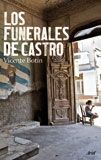New Spanish Books: The online guide of titles from Spanish publishers and literary agents with rights for translation in the UK. To consult titles available in other markets please click on the above links.
Los funerales de Castro

After four years as Cuban correspondent for Television Española, nothing should surprise me anymore. However, this is not the case. Cuba, like Magritte’s pipe, is not an island but the image of an island. To know what daily life in Cuba is really like, to understand that it has two states of being; one real, the other virtual, and that Cubans ‘live both at once without going mad, as portrayed in Richard Danenberg’s bolero, you have to live there. Cuba is not the happy place depicted in the media. Its citizens’ hardships are not the consequence of the blockade imposed by the United States, a country that, paradoxically, has become the principal provider of food to an island which used to be a net exporter. The real situation in Cuba must be brought to light, and this is what I have tried to do with Castro’s Funerals. It is the result of rigorous research and direct interaction with Cubans, drawing on documents that were very difficult to obtain, and above all keep hold of, thanks to the strict vigilance that the State Security exercises on foreign journalists. This is a serious book written with plenty of irony and a sense of humour, and also includes the poetry and songs, especially boleros, with which Cubans try to exorcize their demons. To paraphrase the poet Francisco Riverón Hernández, the book, ‘was born of eyes that have seen, ears that have heard and hands that have done.’
